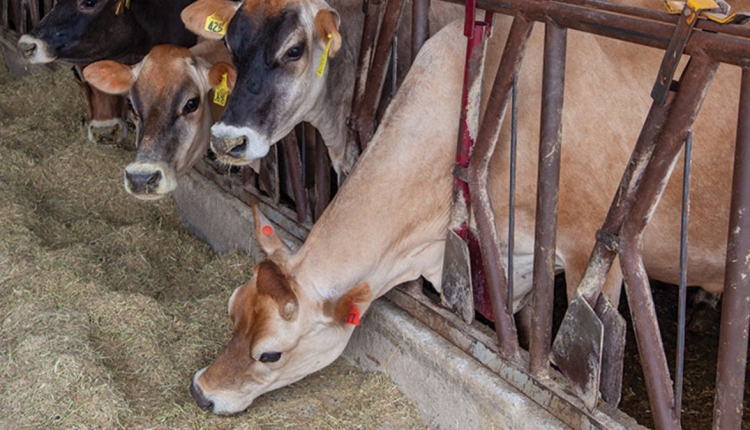Uneaten forage is now more expensive |
| By Mike Brouk |
|
|
|
The author is a professor and extension dairy specialist with Kansas State University.  How much feed is left behind in the feedbunk? Is it mostly forage? Is it 1 or 2 pounds per head? What did that forage cost? These questions demand consideration during a time when the market value of hay is at record levels. Feeding alfalfa at its current price might be adding 8.5 to 17 cents to the daily costs of feeding each cow in a dairy herd. If you are feeding 500 cows, and if this leftover feed is discarded, this could be costing your operation $1,275 to $2,550 each month. So, what can you do if the cows are not consuming all the forage in their ration? First, examine the refused feed. If it is mostly hay particles, look at their length. To stimulate rumination, particles only need to be 2 inches. Particles that are longer than this and left behind in the bunk are of little rumination value. Next, look at the width or coarseness of the hay particles. Are the particles something other than alfalfa? Other plant types may simply be unpalatable to the cows. If the alfalfa is contaminated with weeds or it has coarse stems, you may need to consider a different hay source. This might raise the cost of hay in the ration, but if the cows consume all of the particles, you can afford to spend a little more on purchased hay. Using the example above, if you are feeding 10 pounds of alfalfa per head each day, you could spend $17 to $34 more per ton on your alfalfa and not raise your actual feed cost. If you are currently feeding 140 to 150 relative feed value (RFV) hay and discarding 1 to 2 pounds from the bunk, improving the hay quality may solve the issue. This could also boost milk production. If improving hay quality is not the answer, further processing will likely reduce the particle size to 2 inches. This could be accomplished by grinding the hay through a smaller screen. If you are currently using a screen with a 4-inch opening, reducing to a 3-inch opening would likely be a solution. Check your mixer If you use your total mixed ration (TMR) mixer to process hay, it may be time to do some maintenance and replace worn knives. While replacing the knives, also look at the condition of the corners that move feed into the screw or reel. Many times, these parts are not replaced, and forage tends to remain in these areas rather than mixing into the load. Adjustment of these corners may also be necessary. Attention to the condition and setting of the corners is an important part of TMR mixer maintenance. You may also need to extend the processing time for the hay. Sometimes adding as little as five additional minutes to the mixing time can significantly reduce hay particle size. In addition to checking the particle size of the forage, you might need to consider the overall dry matter of the TMR. Recent research has shown that reducing the dry matter of the TMR of lactating dairy cows to 45% resulted in higher intakes and milk production. This is wetter than past recommendations, but it is working on many farms. Adding water to the TMR only requires a little more time, and the water is inexpensive. With rising feed costs, many dairies have greatly reduced the amount of refused feed that is discarded or have utilized it for other animals. Feeding for a clean bunk is possible, but you will need to pay additional attention to hay quality and hay processing. Watch the feedbunk carefully or consider installing some game trail cameras along the bunk so that you can review what happens in the bunk over time. If the cows are sorting out longer pieces of hay, the bunk may be effectively empty for several hours each day while the animals consume the remaining pieces of hay. If this is the case, you are likely reducing the cows’ dry matter intake. Forcing animals to consume feed can be a costly practice. With lactating dairy cows, boosting feed intake by 1 pound generally results in 3 pounds of additional milk. If milk is worth $20 per hundredweight, this is a 60-cent daily opportunity for each cow in your herd. Yes, it will take a little more feed, but this is likely a 3-to-1 return on the investment. Forage costs will likely not decline over the next year, and with higher fuel and transportation costs, we may see feed prices rise. Make sure that animals are willing to consume the forage that is fed by directing additional attention to the quality and processing of your forage. This article appeared in the April/May 2022 issue of Hay & Forage Grower on page 12. Not a subscriber? Click to get the print magazine. |
